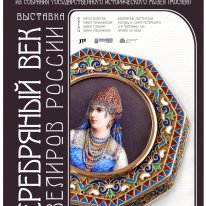"The Silver Age of Russian Jewelers" exhibition
- 08.09.2018
September 8, 2018. The National Historical Museum of the Republic of Belarus opens "The Silver Age of Russian Jewelers" exhibition (from the collection of State Historical Museum, Moscow).
The important part of Russian culture is gold and silversmithing, that went through the period of prosperity in the second half of the 19th – early 20th centuries. It was also a period of radical style changes. The high level of culture and production allowed to use elements of previous styles in the decor, as well as to enrich the jewellery in general. At the turn of XXth century, the unique style of national romanticism was created. This style inventively synthesized the Russian style with Art Nouveau.
Such artists as V. Vasnetsov, M. Vrubel, V. Polenov, N. Roerich are considered as the founders of national romanticism. They turned to the handicraft and substantially enriched the decor with new patterns, as well as romantic and mythical motives.
In the latter half of XIX – early XX centuries, Moscow and St. Petersburg were the main centers of jewellery production. Petersburg was a trendsetter, the stylistic directions were mainly focused on West European culture. Moscow School was formed on the basis of ancient traditions and folk art. That way, almost all the factories and workshops (there were about 500 manufactories in Moscow) produced pieces in Russian style.
The Moscow Jewellery School is represented by the pieces of following firms and workshops: the I. Gubkin firm, a supplier of the Russian Imperial Court; the I. Ovchinnikov workshop, which is known for revival and development of the national style. There are works of the I. Khlebnikov firm, that is specializing in the gold and silverware manufacturing, and also the pieces of F. Ruckert firm, marked by an unique ornamentation, going deep into pre–Christian art.
St. Petersburg school is represented by the famous House of C. Fabergé. The House's works were inspired by royal styles of Louis XV and Louis XVI. There was a branch office in Moscow. Furthermore, there is the I. Britsyn workshop called "Russian Enamel", which created the pieces with enamel of transparent and complex shades. The jewellery of the Grachev brothers' company is playing a special part in the exposition. The pieces of their company are awarded at international exhibitions in Copenhagen, Chicago and Nizhny Novgorod; the firm of P. Sazikov, who is rightfully considered as one of the founders of Russian style in jewellery art.
The exhibition also introduces a number of other jewellery houses, workshops, and individual jewelers of this time in Russia: the pieces of workmanship by P. Agafonov, S. Wisenger, K. Skvortsov, as well as the workshops of P. Americantsev, M. Sokolov, the firms of N. Nemirov–Kolodkin , A. Tillander, the factories of A. Sparyshkin, A. Fulda.
A special section of the exposition is "The Silver of Russian Army". There are drinking sets, wine bowls, buckets, decorated with images of historical battles, carved letterings and proverbs. There are also many silver items of regiments that set out festive table. These objects served as gifts to Officer Assemblies, presented by chiefs and commanders on the occasion of various anniversaries.
In total, the exhibition shows 149 rarities from the leading Russian historical museum, while the weight of silverware on view is 79,380 gr.
The exhibition is organized with the support of JTI company.
For visitors
opening hours
Open: 11.00–19.00
Daily
Ticket desk open: 11.00 – 18.30
Visitors enter: 11.00 – 18.30
admission
Adults:
Permanent exhibitions tour –
Br 10 BYN
Guided tour –
Br 30 BYN
Full-time students:
Permanent exhibitions tour –
Br 8 BYN
Guided tour –
Br 25 BYN
Schoolchildren and specialised secondary school students:
Permanent exhibitions tour –
Br 5 BYN
Guided tour –
Br 15 BYN
Retirees:
Permanent excibitions tour – 5 BYN
Guided tour – 15 BYN
Contacts
12 Vulica Karla Marksa, Minsk, 220030, Republic of Belarus
+375 17 3237665
+375 17 3748322
+375 17 3654827
histmuseum@histmuseum.by
Scientific department
office@histmuseum.by
Museum reception









